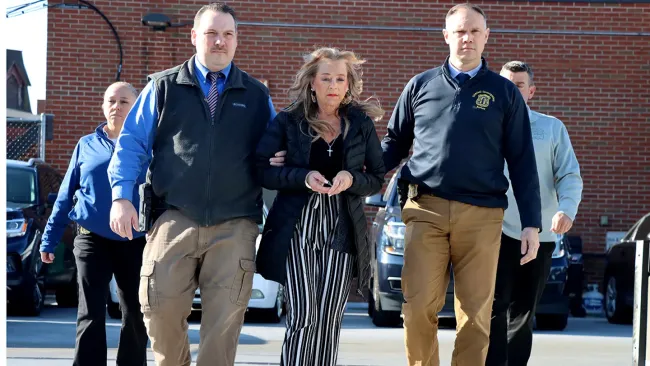Kimberly Sullivan Case: Connecticut Stepmother Accused of Holding Stepson Captive for 20 Years in “House of Horrors”
Kimberly Sullivan, a 56-year-old from Waterbury, Connecticut, is accused of holding her stepson captive for over 20 years in conditions of severe neglect. Learn about the shocking allegations, the victim’s escape, legal proceedings, and the systemic failures behind this chilling case.
Kimberly Sullivan: The Connecticut “House of Horrors” Case That Shook America
In one of the most disturbing abuse cases in recent memory, Kimberly Sullivan, 56, from Waterbury, Connecticut, stands accused of imprisoning her stepson for over two decades. The horrifying allegations describe years of starvation, confinement, and psychological torture, beginning when the boy was just 11 years old.
The ordeal reportedly ended in February 2025, when the now 32-year-old victim set fire to the home in a desperate attempt to escape. What rescuers found inside shocked even seasoned investigators — a malnourished man weighing just 68–70 pounds at 5-foot-9, with rotting teeth, matted hair, and signs of severe neglect.
Allegations: Two Decades of Captivity and Neglect
According to police affidavits and court documents, the victim’s nightmare began in the early 2000s when Sullivan withdrew him from school. Initially locked in his room at night to prevent food scavenging, the confinement soon escalated to full isolation in an 8-by-9-foot storage closet, reinforced with plywood and multiple locks.
His daily sustenance allegedly consisted of two sandwiches and a small cup of water, leading to extreme malnutrition. He had no access to medical care, sunlight, or human contact for years.
The victim described using makeshift methods to survive — such as urinating through a straw funnel out the window and counting passing cars to maintain sanity. His only outings were brief, supervised moments in the backyard, mostly to walk the dog.
The Escape: Fire and Freedom
On February 17, 2025, the victim discovered a lighter hidden in his late father’s jacket and made a desperate plan for freedom. He ignited printer paper and hand sanitizer, setting the house ablaze. Firefighters rescued him as flames spread through the home.
“I wanted my freedom,” he told first responders. Though he suffered burns and smoke inhalation, his act finally ended over 20 years of captivity.
Timeline of Key Events
| Date/Period | Event | Details |
|---|---|---|
| ~1993 | Victim born | Given up for adoption at 6 months, later raised by father and Kimberly Sullivan. |
| 2002–2004 | Early confinement | Withdrawn from school; locked in room; isolation begins. |
| 2004–2005 | Welfare checks | DCF visits home twice but takes no action. |
| Jan 2024 | Father’s death | Sullivan becomes sole guardian; restrictions tighten. |
| Feb 17, 2025 | Fire and escape | Victim sets fire, rescued, and reveals abuse. |
| Mar 12, 2025 | Arrest | Sullivan charged with kidnapping, assault, and cruelty. |
| Jul 29, 2025 | DCF review | Confirms six unacted welfare visits over nine years. |
| Oct 31, 2025 | Latest court ruling | Judge allows Sullivan access to victim’s alias and medical files. |
Inside the “House of Horrors”
Photos released by investigators depict a charred, cluttered home, with haunting details — a melted Marilyn Monroe poster, burnt furniture, and the remnants of a tiny locked room where the victim lived.
Neighbors described Sullivan as “cold and secretive,” and some claimed they never knew a boy lived there. Meanwhile, her two biological daughters reportedly moved freely around the house.
Legal Proceedings and Defense
Sullivan has pleaded not guilty to all charges, including:
- First-degree assault
- Second-degree kidnapping
- First-degree unlawful restraint
- Cruelty to persons
- Reckless endangerment
Her attorney, Ioannis Kaloidis, insists that she did not restrain the victim and claims the late father dictated his care. The defense argues she provided food and shelter, portraying her as misunderstood rather than malicious.
In a controversial ruling, the court granted Sullivan access to the victim’s new identity and medical records, prompting outrage from advocates and the biological mother, Tracy Vallerand, who called the decision “appalling.”
Systemic Failures and Public Outcry
This case has ignited national outrage and renewed scrutiny of Connecticut’s child welfare system. Despite multiple Department of Children and Families (DCF) visits between 2004 and 2013, no intervention occurred.
Social media platforms like X (formerly Twitter) have exploded with commentary, labeling Sullivan “pure evil” and demanding accountability for decades of bureaucratic oversight.
Waterbury Police Chief Fernando Spagnolo called it “the worst treatment of humanity” he’s seen in 33 years. Local leaders, including Mayor Paul Pernerewski, have pledged ongoing support for the victim’s recovery.
The Victim’s Recovery
Now in a medical and rehabilitation facility, the survivor continues to recover physically and psychologically. His statement, released through authorities, described his years of “captivity, abuse, and starvation.”
Despite his trauma, officials say he is making slow progress toward rebuilding his life, supported by extended family and advocates.
The Broader Impact
The Kimberly Sullivan case stands as a grim reminder of how domestic abuse and isolation can go undetected for years — even in suburban neighborhoods. It underscores the urgent need for better oversight by welfare agencies, schools, and law enforcement.
As the trial continues, the public watches closely, demanding justice not only for one man but for all the invisible victims of systemic neglect.
